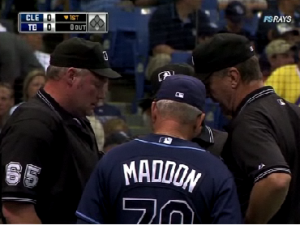
Not funny at the time
Like golf, baseball still has some touchingly quaint pen-and-paper blue laws, and when Tampa Bay Rays manager Joe Maddon signed an incorrectly filled out scorecard for Sunday’s game against Cleveland, the Rays lost their designated-hitter privileges (the American League allows the DH to bat for the pitcher). As such, pitcher Andy Sonnanstine, who shouldn’t have normally had to bat at all, wound up not just having to bat, but having to bat third—the lineup spot normally reserved for the best hitter on the team.
Sonnastine did just what would be expected of a #3 hitter: he went 1-for-3, with an RBI double in the fourth inning. Tampa Bay won the game, 7-5.
Of course, 1-for-3 is hardly evidence of anything. Even AL pitchers get hits every now and then. And maybe Sonnastine also secretly happens to be a good-hitting AL pitcher (there’s insufficient but still interesting evidence of that: he’s 5-for-13—.385—in his career).
But another account (also with insufficient evidence) would be that he was made to feel like a #3 hitter on Sunday, so he performed like one. That explanation would dovetail nicely with the growing body of experimental literature pointing toward the fact that merely sticking someone with a label that has positive or negative connotations—even when that person knows the labeling process to have been completely arbitrary—affects his or her performance on basic tasks, even when he or she has a financial incentive to perform well.
What would be interesting would be an analysis across Major League Baseball of how the same hitters perform when they’re in lineup spots with high expectations (e.g. #3 or #4) vs. low expectations (#8 or #9). You’d have to control for other effects of situation (e.g. who’s on base) and lineup (e.g. who’s on deck). Anyone want to mine the Elias Sports Bureau and check this out?



Vinnie
I would recommend contacting the people at Baseball Prospectus, FanGraphs Baseball, or the guys who wrote The Book: http://www.insidethebook.com/
Almost all the research I’ve seen on lineup positioning regards the effect of batting order on team performance (which is small but tangible) rather than the effect of lineup position on individual players. It’s an interesting question that I’d imagine would be all but impossible to control for, but the creative minds at any of these sites could probably find a decent method.
Theo
Robin, can’t believe I missed this when it happened. I think my attention was focused too much on the NBA playoffs.
I’ve actually thought a lot about pitchers and their supposed crappy AVGs. Pitchers who hit (usually starters; relievers never get a chance) generally only get to bat once every five games. I’m betting their averages would be in line with the lower third of the lineup if they had the consistent opportunity.
I also find it interesting that while he went 1-3, that actually brought his career average DOWN.